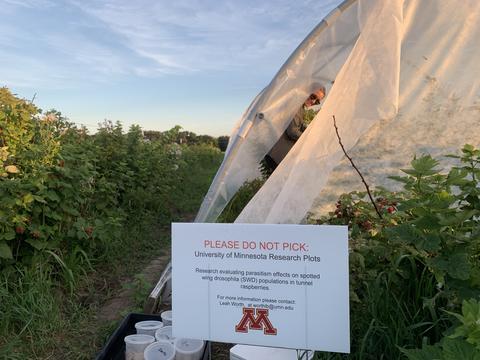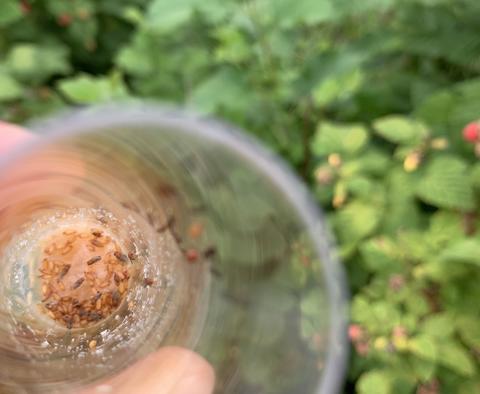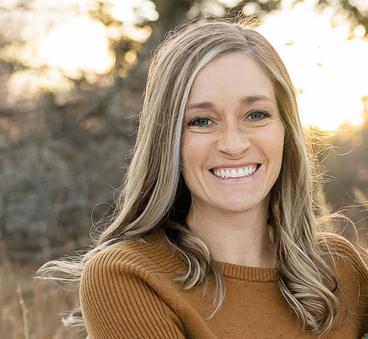Leah is from a small town in west-central Iowa, where her love for gardening and growing fruits and vegetables began. She attended Iowa State University and received her BS in Horticultural Science, with a minor in Agronomy. Following graduation she embarked in a Service Learning Program with ISU and taught Ugandan 5th and 6th graders soils and plant propagation techniques for a summer. She continued her passion for horticultural crops as an Ag Specialist with Iowa State University's Research Farms; working with cultivar hardiness trials of wine grapes, high tunnel brambles, ornamental shrubs, and various other high tunnel speciality crops. Leah's interest in high tunnel bramble production lead her to obtain her MS degree in Horticultural Science, where she studied the effects of temperature and light on high tunnel red raspberry production. She further worked as the Horticulture Program Coordinator with Jasper County, ISU Extension and Outreach. From there she went on to the Iowa Arboretum, where she managed 120 acres of natural (woodlands and prairie) and garden spaces. She joined the Rogers' team in March of 2020, focusing her efforts on spotted-wing drosophila (Drosophila suzukii) exclusion and biological control efforts in tunnel raspberries. She also manages the Rogers lab website, designs and distributes the Student Organic Farm monthly newsletter, co-authors research reports and manuscripts in peer reviewed journals, and recently started as a teaching assistant for Hort 5033 with Dr. Rogers. In her free time Leah enjoys embarking on biking, hiking, kayaking, and camping adventures with her partner, Jesse, and their daughter, Luna.
Publications
Worth, L.B., Rogers, M.A., Flavin-Hodge, C., and Schweser, G. (2023). Deep winter greenhouses for organic production of leafy greens in the northern United States. Acta Hortic. 1377, 9-24
DOI: 10.17660/ActaHortic.2023.1377.2
Worth, L., Rogers, M., and Reardon, A. (2023). Biocompatibility of OMRI listed insecticides on green lacewing (Chrysoperla carnea) larval mortality: implications for greenhouse vegetable production. University of Minnesota Digital Conservancy.
Hogg, B. N., Lee, J. C., Rogers, M. A., Worth, L., Nieto, D. J., Stahl, J. M. and Daane, K. M. (2022). Releases of the parasitoid Pachycrepoideus vindemmiae for augmentative biological control of spotted wing drosophila, Drosophila suzukii. Biological Control. 168, 104865.
Worth, L., Rogers, M., and Reardon, A. (2022). Butterhead lettuce variety performance trial in a hydroponic NFT system. In: Midwest Vegetable Trial Reports. Paper 235.
Klodd, A. and Worth, L. (2021). Organic High Tunnel Raspberry Production. University of Minnesota Digital Conservancy.
Field Research
Spotted-wing drosophila (Drosophila suzukii) was first detected in the United States in 2008, and gradually appeared in the Upper Midwest in 2012. It has been found to attack over 60 plant species, with the bramble crops being some of the hardest affected. While synthetic sprays are widely available to commercial growers, the rapid ripening of bramble fruit and long re-entry intervals of these insecticides don't work in organic production. Therefore, we have been investigating the effectiveness of parasitic wasps as a biological control strategy for SWD control. At this time, research has only identified two parasitic wasp species that successfully parasitize SWD in a natural environment. We rendered nine-year old 'Nova' red-raspberries and the parasitic wasp species, Pachycrepoideus vindemmiae (Pv), for our study. Our methodology included using enclosed tunnels which we artificially infested with SWD; providing the ability to exclude natural pests and predators from entering the tunnels, as well as inhibiting SWD and Pv from exiting. Our research objective was to determine if and at what population threshold is Pv effective in controlling SWD. These results are significant for developing a SWD pest management strategy in organic production.


